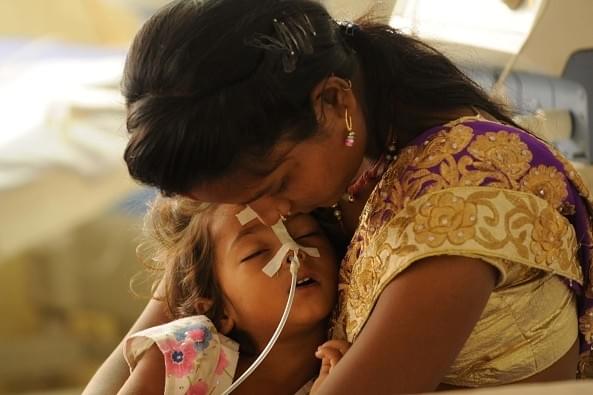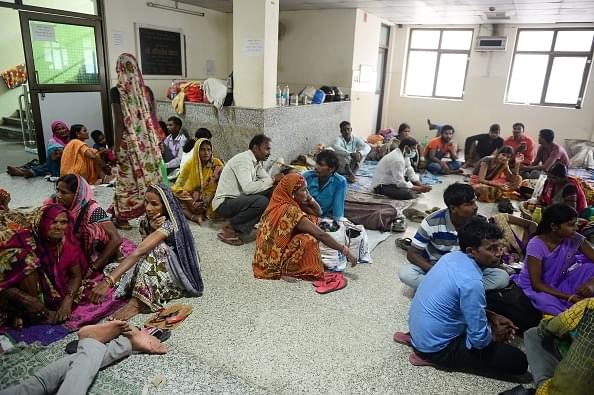Ideas
Gorakhpur Study Finds Only 2 Per Cent Encephalitis Patients Have Scrub Typhus – Theory Discredited?
Swarajya Staff
Jul 25, 2018, 05:21 PM | Updated 05:21 PM IST
Save & read from anywhere!
Bookmark stories for easy access on any device or the Swarajya app.


The Gorakhpur case of 2017, where scores of children died in state-run Baba Raghav Das Medical College and Hospital within hours, brought the scourge of encephalitis to national limelight.
Though the hospital deaths were initially blamed on an abrupt cut in oxygen supply, the state government has maintained that it was the deadly encephalitis (called Acute Encephalitis Syndrome or AES in medical parlance) at work.
The epidemic hits Eastern Uttar Pradesh with a particular fury year after year. It has claimed a staggering 10,000 children’s lives within the hospital’s walls since 1978 - the year when the phenomenon was first documented in the region. However mediocre it may be, the 40-year-old hospital is the only hope for critical patients of encephalitis in the 300-km radius of Gorakhpur.
But what has always remained a mystery is the trigger for AES. What brings patients - who are children below 10 years of age in 85 per cent of the cases - to the hospital in the first place remains unknown.
Is it the Japanese encephalitis (JE) virus or Enterovirus or Scrub Typhus?

In the 80s, when the phenomenon was first studied, researchers declared JE virus as the cause as it figured in more than a quarter of AES cases. But the theory lost takers when it was observed that in the coming years, vaccines brought down JE cases considerably but overall AES cases didn't drop. On the contrary, they went up.
Next, researchers decided that a polio-like virus called Enterovirus, which spreads through faecal-contaminated water, is the main trigger for AES in this particularly laggard region of UP. A 2012 study by the National Institute of Virology (NIV) found 10 per cent positivity in 1,000 samples, giving the theory some credence.
However, a study in 2016 shifted opinions sharply. It concluded Scrub Typhus as the main cause for encephalitis in the region. Scrub Typhus, caused by the Orientia tsutsugamushi bacterium, was detected in as high as 65 per cent of encephalitis cases.
But a new report has raised questions on the Scrub Typhus theory.
A much-awaited study on the presence of Scrub Typhus in AES patients in 2018 is out. An exclusive report by Hindi daily Hindustan says that only five out of 235 AES patients have been found to have Scrub Typhus. This is merely 2 per cent positivity, which is in sharp contrast to the expected 65 per cent positivity.
The Hindustan report gives these details: A total of 245 encephalitis patients have been admitted to BRD hospital since January, out of which 80 have died. Samples of blood and cerebrospinal fluid of 235 patients were sent to the Gorakhpur unit of NIV. The report has found that 230 patients did now show presence of Scrub Typhus. The five patients who did, belong to Gorakhpur, Deoria and Kushinagar districts.
The 2016 study on Scrub Typhus, that created a sensation of sorts, was jointly carried out by doctors from BRD in Gorakhpur, National Institute of Epidemiology in Chennai, Christian Medical College in Vellore, National Institute of Virology in Gorakhpur and Indian Council of Medical Research (ICMR) in Delhi.

Prompted by the findings, the ICMR had advised the Uttar Pradesh government to administer Scrub Typhus antibiotics to all patients with fever for five days from the beginning of 2017 itself. If a Scrub Typhus patient takes antibiotics in the early days, the disease is easily curable. If not, it advances to AES, triggering brain inflammation.
The government, however, ignored the advice until the Gorakhpur controversy broke out. As reported by Swarajya earlier, Dr Ravindra Kumar Srivastava, former chief medical officer (CMO) of Gorakhpur, said that Doxycycline and Azithromycin antibiotics were duly given to all such patients from September 2017 onwards.
But now that the NIV findings have raised questions on the Scrub Typhus theory - at least as of now - critics are questioning why the government gave unnecessary antibiotics to patients at all. Dr R N Singh, a former BRD doctor and long-time campaigner against encephalitis, told Swarajya that he had always objected to the Scrub Typhus study because "it just didn't make sense".
"I was a part of the Indian Medical Association meet when the study was first presented. My argument was that Scrub Typhus mainly occurs in cool weather, so an epidemic isn’t quite possible in this region. But at that time, my arguments were ignored," Dr Singh told Swarajya over the phone.
Going by decades of experience, Dr Singh suspects Enterovirus to be the cause in 75 per cent of cases and has always emphasised on better sanitation as the solution. It is to be noted that AES is not a diagnosis, it is merely a clinical term for a wide spectrum of diseases that manifest as brain inflammation. Simply put, AES is a huge category of diseases and can be caused by any of the three dozen bugs including various viruses, bacteria and fungi.
The NIV report, however, doesn't settle the debate on Scrub Typhus, as per Dr Pushkar Anand, additional director at BRD. He told Swarajya over the phone, "The NIV report is not 100 per cent authentic. There are loopholes."
Dr Anand didn't, however, elaborate on the loopholes saying it's "controversial", but told Swarajya that the hospital will continue to give antibiotics for Scrub Typhus. "There is still no consensus," he said, politely declining to speak further on the matter.





